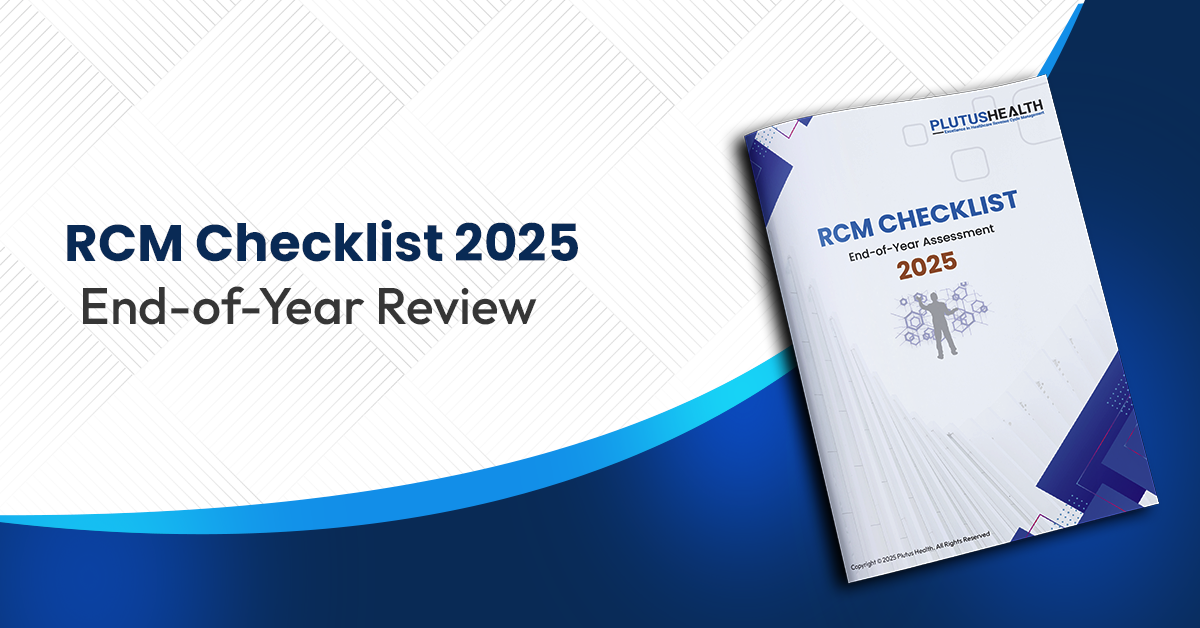Future-proof your AR Processes
Creating a smooth billing process for your medical practice saves time and boosts revenue. By contrast, if practices do not manage their accounts receivable (AR) well, they will find their revenues dropping.
This drop can easily lead to a quality spiral, where poor cash flow leads to poor care and vice versa. Practices that adopt modern technology, streamline workflows, and have consistent standards may avoid this mishap.
Here is the best process for managing accounts receivable.
Report your Billing History
A functional billing team must complete regular reports for review. These documents help the team understand why the revenue cycle is in its current state. Data is crucial to construct an improvement plan based on what has worked.
Here are a few items that are most helpful to track.
- Cost to Collect Patient Revenue: Measure how much you have to spend to collect a dollar of revenue. Cash as a Percent of Net Patient Services: Recording this percentage measures how your practice translates services into revenue from patients.
- Claim Denial Reason: Section denials by reason to learn what errors are most common.
- Claim Denial Rate: Separate insurance payers to determine which ones have requirements that clash with your process.
- Days in Accounts Receivable: This metric helps get a picture of the AR split by Insurance and Patients. Ideally, days in AR should stay below 40.
Prevent Insurance Denials
Payers deny claims an average of 5%-10%. The most common reasons for denials include the patient not being covered under the plan, missed deadlines (TFL), duplicate claims, and inaccurate or missing information. Most of these denials are fixable with a rework and resubmission. However, these resubmissions can cost thousands of dollars, so guide your team with SOPs to avoid errors.
After scheduling a patient:
- Double-check their personal information and insurance details.
- Recheck patient verification around 24 hours before the scheduled visit.
- If the insurance standards have shifted since the scheduling date, inform the patient of the changes.
Once the patient arrives, have them verify their personal information. Technologically savvy providers can have patients do this online before arriving.
Review Workflow
For a report to be successful, a team member must review and create a workflow plan. With an accurate, well-organized report, a competent planner can map out a clear path of improvement. A solid first step towards improvement is consistently setting up patients with financial technology (fintech). These systems maximize collections by helping patients pay their bills quickly.
Ensure that your team knows the report-making and reviewing process. Reinforce how to avoid claim denials and how to resubmit. Review your records when a denial arrives. Go through your patient information to ensure that it is accurate. And correct any discrepancies you find any.
Do this same process for insurance codes to ensure compliance. Assign different team members to a subset of payers. If your denial rate is higher than 10%, consider hiring a professional billing service to help your practice recover.
Maximize Technology
Modern technology excels at boosting efficiency and reducing work hours. And health services that don't keep up with this modern technology risk the chance of becoming outdated. A common reason for practices failing to follow up on denied claims is lack of time or staff bandwidth. Thankfully, medical systems can automatically pre-verify authorization, creating more time for staff.
Advanced EHR systems will also notify staff to review critical information for an insurance claim. Ensure that your personnel understands this system to maximize utility.
A professional company can immediately improve AR quality if your team is consistently challenged to meet its AR standards. Plutus Health makes managing the modern revenue cycle landscape easier for your practice. If you are struggling with billing, collections, and management, our expert team will get the fastest reimbursement possible and increase your practice's performance.
Key Takeaways
1. Create and review regular reports that provide trends.
2. Review insurance codes and patient information to correct any discrepancies.
3. Manage your team's workflow to ensure maximum efficiency.
4. Use up-to-date technology to stay abreast with modern advancements.
Liked the blog? Share it
FAQs


ABA providers are grappling with high staff turnover (up to 65%), rising burnout, administrative overload, and stagnant reimbursement rates. These challenges directly impact care continuity, clinical outcomes, and operational performance.


Operational inefficiency costs ABA teams up to 10 hours per staff member per week, contributing to burnout, denied claims, and longer accounts receivable (A/R) cycles. These inefficiencies ultimately result in reduced revenue and patient dissatisfaction.


Burnout leads to costly turnover, lower client retention, and decreased productivity. Recruiting and replacing a BCBA or RBT can cost up to $5,000 per hire, plus months of lost revenue and disruption to morale.


High-performing ABA organizations invest in clear career pathways for BCBAs and RBTs, align compensation with market benchmarks, and foster peer-led mentorship, flexible schedules, and wellness programs.


Automation tools like Plutus Health's Zeus streamline eligibility verification, denial management, and billing, reducing manual workloads by 5–10 hours weekly per clinician and improving clean claim rates by 95%.


Outsourcing revenue cycle management can improve collections, reduce denials by up to 30%, and free clinicians from billing-related admin tasks, resulting in better client care and financial outcomes.


One $200 million ABA network partnered with Plutus Health to automate eligibility and accounts receivable (A/R) processes. The result: $2M reduction in legacy A/R and a 97% Net Collection Rate.


By improving operational efficiency, investing in technology, and ensuring workforce stability, ABA leaders can align outcomes with reimbursement. Plutus Health supports this transition with scalable RCM and automation strategies.
FAQs


ABA therapy billing is the process of submitting claims to insurance or Medicaid for Applied Behavior Analysis services provided to individuals with autism or developmental disorders. It includes using correct CPT codes, proper documentation, and adherence to payer-specific policies.


Common CPT codes for ABA therapy in 2025 include:
- 97151 – Assessment and treatment planning
- 97153 – Direct therapy with the patient
- 97155 – Supervision and modification of behavior plan
- 97156 – Family adaptive training
- Always check with payers for any annual changes.


To bill Medicaid for ABA services, providers must ensure credentialing is complete, services are pre-authorized, and claims use the correct codes and modifiers. Medicaid requirements vary by state, so always follow state-specific billing rules.


Common ABA billing mistakes include:
- Incorrect or missing CPT codesplan
- Lack of documentation or treatment
- Uncredentialed providers rendering services
- Submitting duplicate or late claims


Without proper credentialing, providers can’t get reimbursed. Insurance and Medicaid require that BCBAs, RBTs, and organizations are credentialed and contracted. Delays in credentialing often cause revenue losses and claim rejections.
FAQs


CMS proposes a 2.4% increase in Medicare ASC payment rates, contingent on meeting ASCQR quality reporting requirements. Plutus Health helps ASCs meet these compliance benchmarks by integrating quality reporting data into RCM workflows, ensuring eligibility for full payment updates.


The ASC Covered Procedures List will expand by 547 procedures, including cardiology, spine, and vascular surgeries. Plutus Health supports expansion into new service lines by customizing RCM processes for high-acuity procedures, minimizing claim denials during the transition.


Site-neutrality narrows the payment gap with hospital outpatient departments, enhancing ASCs' cost-efficiency appeal. Plutus Health helps leverage this advantage in payer negotiations by providing performance dashboards and cost-justification analytics to secure stronger reimbursement terms.


Complex procedures increase denial risk and slow cash flow. Plutus Health's automation-first RCM model delivers 95%+ clean claim rates, reduces A/R days, and safeguards margins, even as your case mix becomes more complex.
FAQs


A hybrid RCM model combines in-house tasks like scheduling, intake, and patient communication with outsourced billing support for claims, denials, and A/R follow-up. Plutus Health enables this model with automation and expert teams.


Frequent CPT code updates, variable session lengths, high no-show rates, and sensitivity around patient collections make behavioral health billing uniquely challenging. Hybrid RCM helps strike a balance between compliance and patient care.


Tasks requiring patient interaction—like intake, eligibility checks, copay collection, and documentation—are best kept in-house, while backend processes can be outsourced.


Outsourcing denial management, claims scrubbing, and payment posting improves clean claim rates, reduces A/R days, and scales capacity without adding staff.


Plutus Health delivers 97%+ clean claim rates, AI-powered denial prediction, and 48-hour claim turnaround. Our hybrid RCM solutions provide behavioral health CFOs with visibility and control, while enhancing financial performance.
FAQs


Payment complexity, high out-of-pocket costs, increasing denials, and value-based care requirements are pushing providers toward more transparent, tech-supported payment systems.


Patients now act like consumers. They expect clear cost estimates, simple bills, digital payment options, and flexible financing.


AI, automation, and digital tools streamline estimates, reduce denials, support payment plans, and allow faster collections through mobile and online payments.


Complex billing questions, insurance confusion, and financial stress require a compassionate approach. Advocates guide patients and protect trust in clinical care.


Plutus Health supports providers with AI-driven denial prevention, predictive analytics, digital payment tools, patient financing, and a seamless platform, such as AnodynePay.


















































